Abstract
An independent quality assurance program has been established by the Division of AIDS, National Institute of Allergy and Infectious Diseases, for monitoring virologic assays performed by nearly 40 laboratories participating in multicenter clinical trials in the United States. Since virologic endpoints are important in evaluating the timing and efficacy of therapeutic interventions, it is imperative that virologic measurements be accurate and uniform. When the quality assurance program was initially created, fewer than 40% of the laboratories could consistently recover human immunodeficiency virus (HIV) from peripheral blood mononuclear cells (PBMCs) of HIV-infected patients. By comparing coculture procedures in the more competent laboratories with those in laboratories who were struggling to isolate virus, optimal conditions were established and nonessential reagents and practices were eliminated. Changes were rapidly introduced into a laboratory when experience dictated that such modifications would result in a favorable outcome. Isolation of HIV was enhanced by optimizing the numbers and ratios of patient and donor cells used in cultures, by standardizing PBMC separation procedures, by using fresh rather than frozen donor PBMCs, by processing whole blood within 24 h, and by using natural delectinated interleukin 2 instead of recombinant interleukin 2 products in existence at that time. Delays of more than 8 h in the addition of phytohemagglutinin-stimulated donor cells to freshly separated patient PBMCs reduced recovery. Phytohemagglutinin in cocultures and the addition of Polybrene and anti-human alpha interferon to media were not important in HIV isolation. The introduction of a consensus protocol based on this information brought most laboratories quickly into compliance. In addition, monthly monitoring has successfully maintained proficiency among the laboratories, a process that is critical for the scientific integrity of collaborative multicenter trials. Problems which might not be appreciated for months are now being resolved early, before data can be compromised unknowingly. This consensus protocol is recommended for any laboratory attempting to isolate HIV for the purpose of standardizing recovery and for accessing virologic endpoints in clinical trials.
Full text
PDF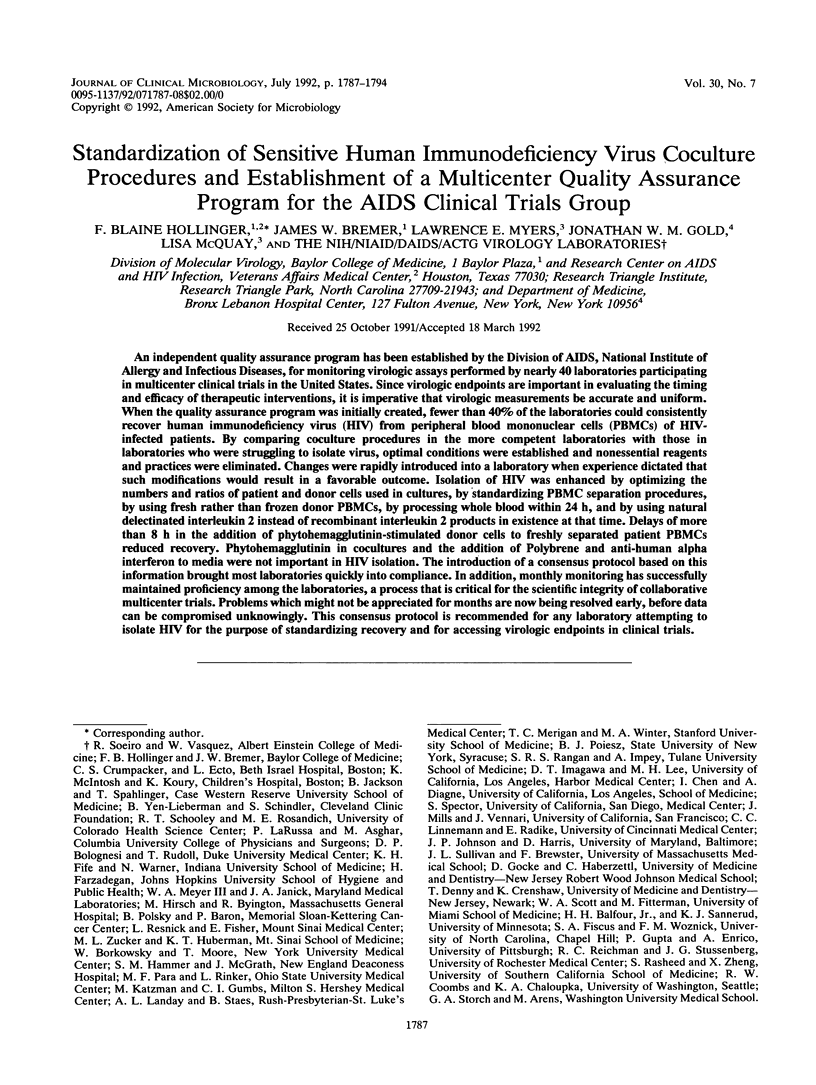
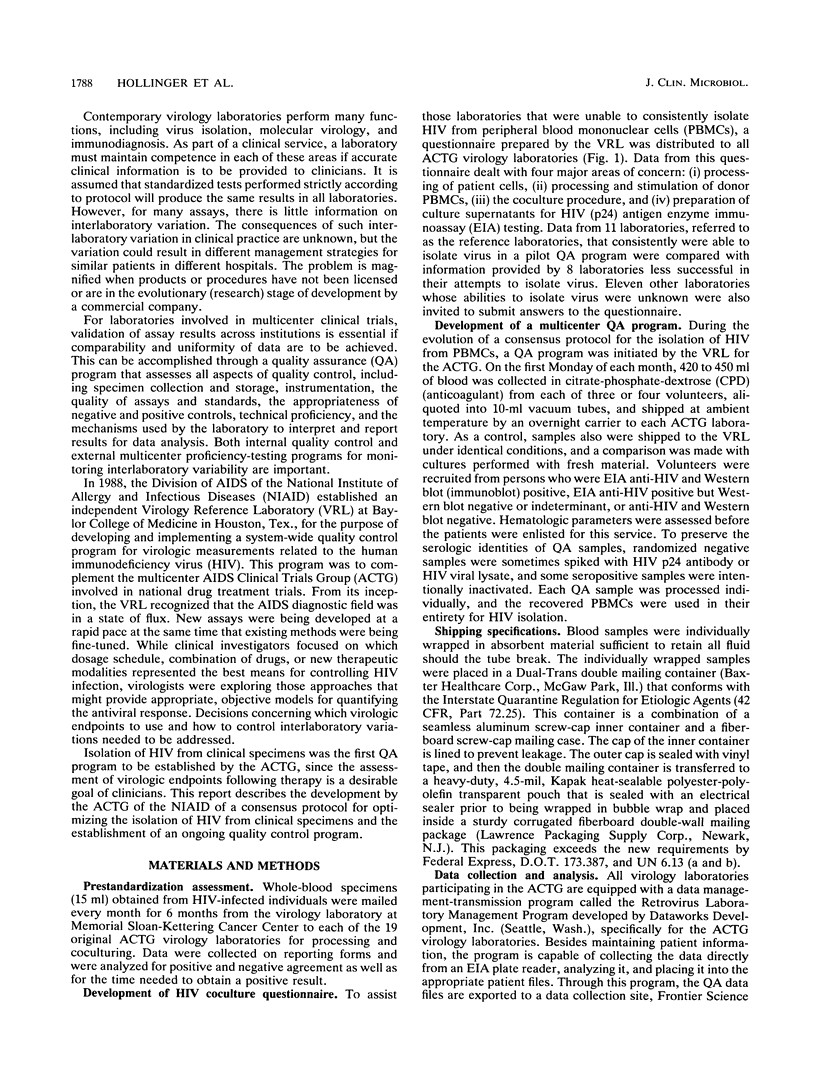
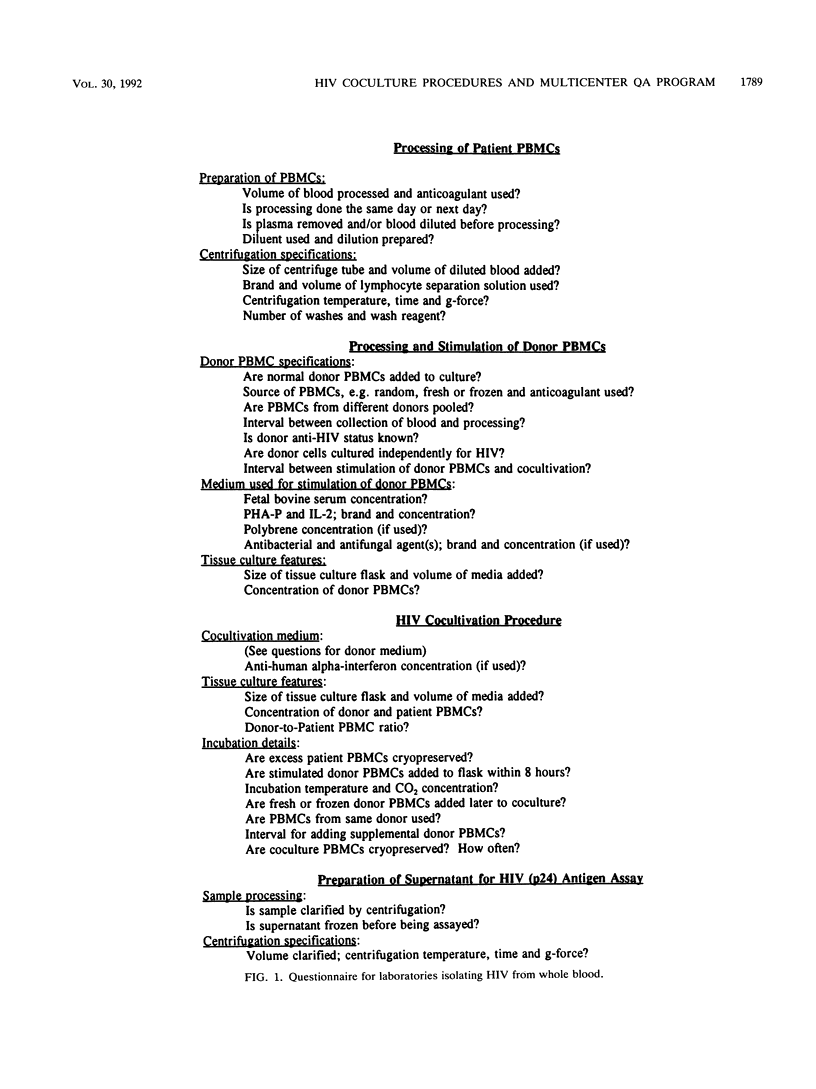
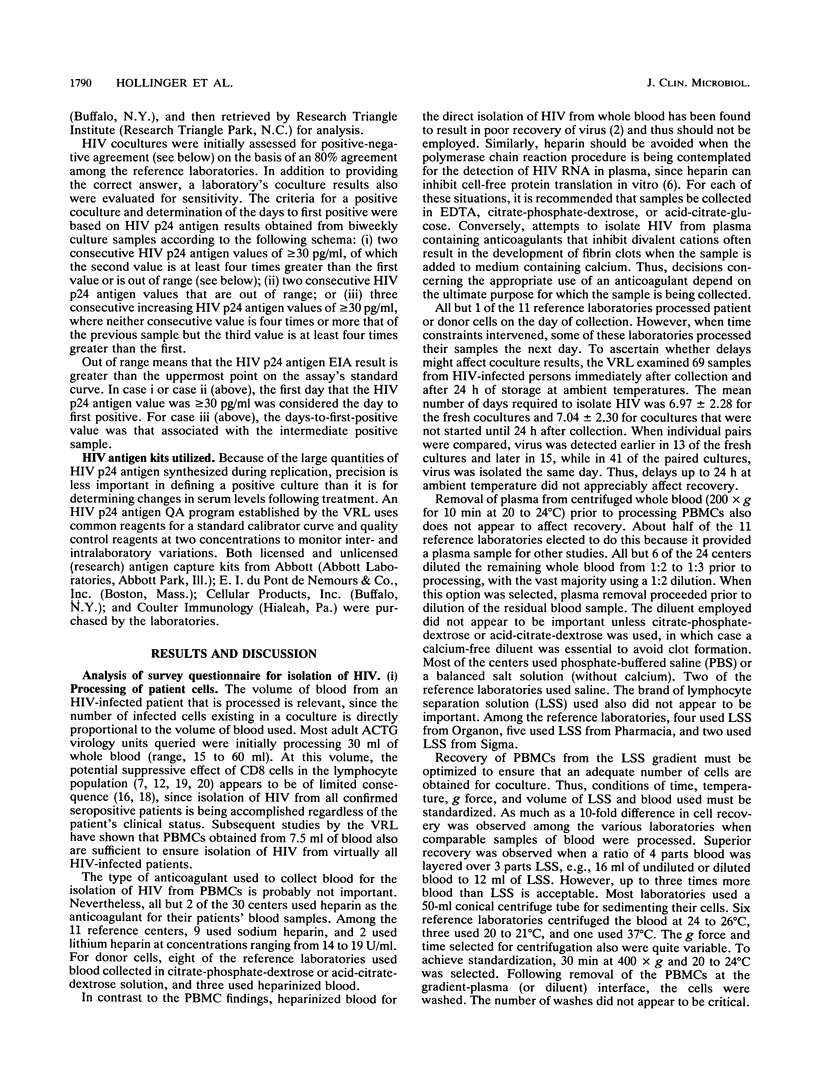
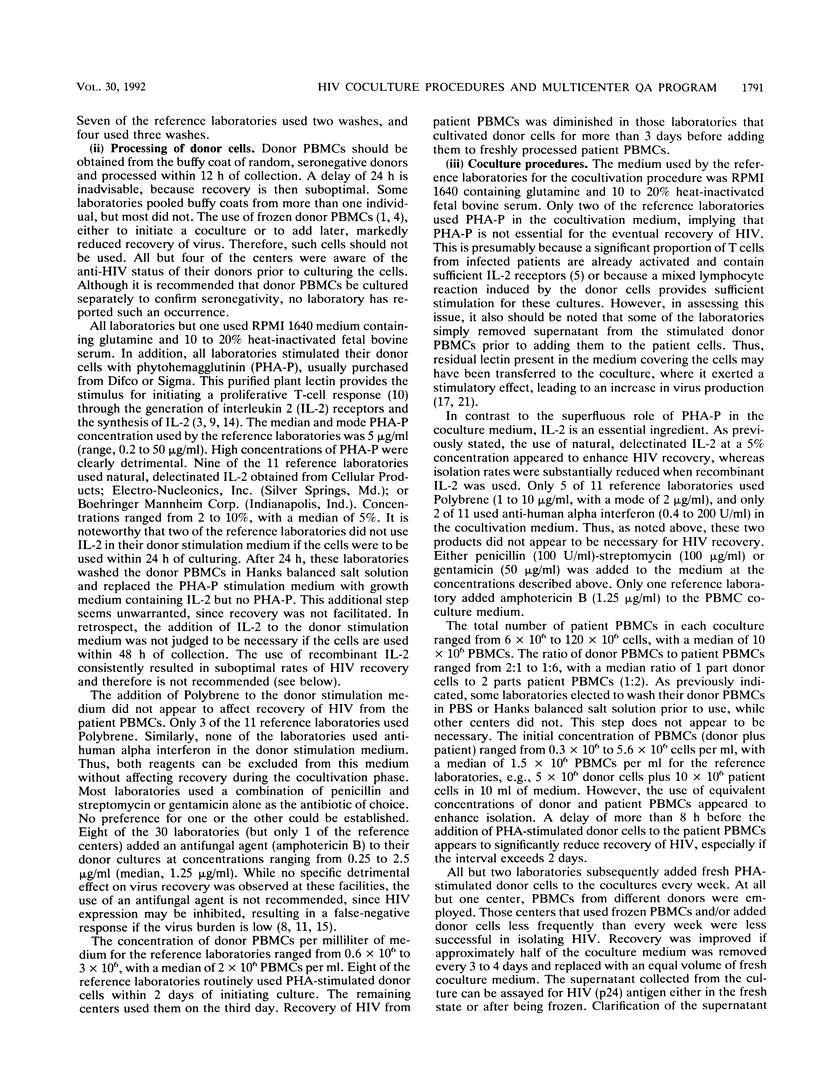
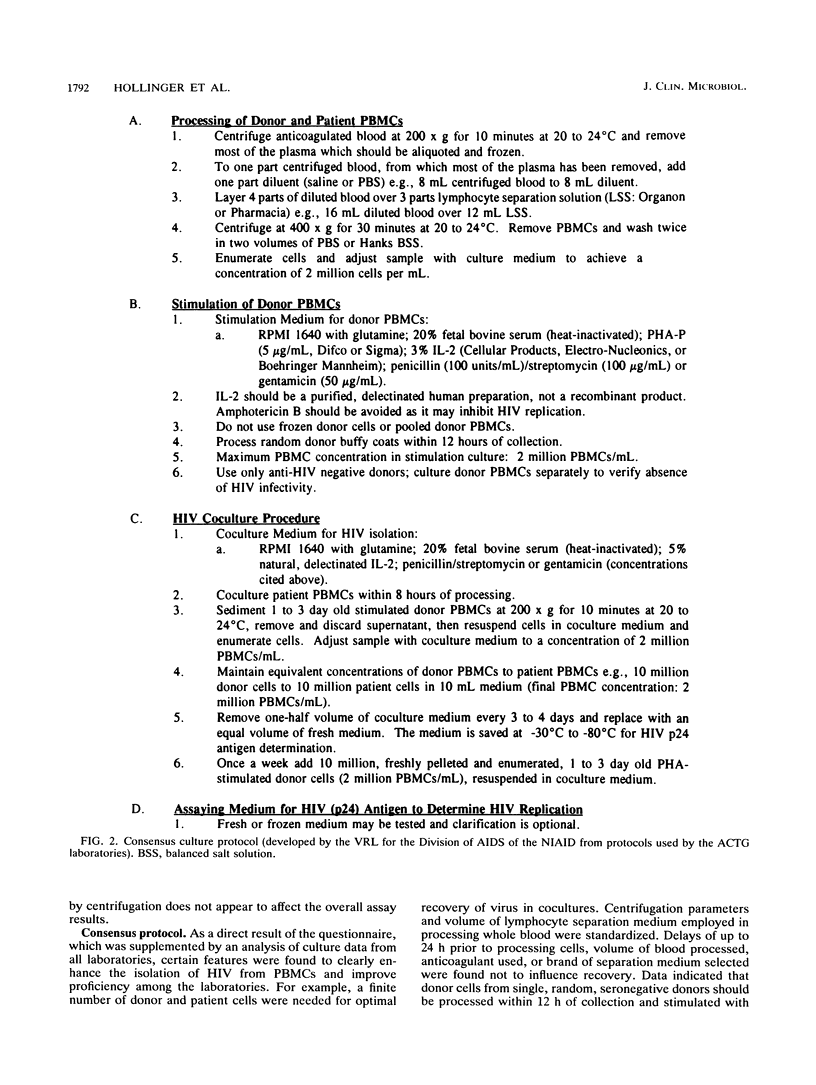
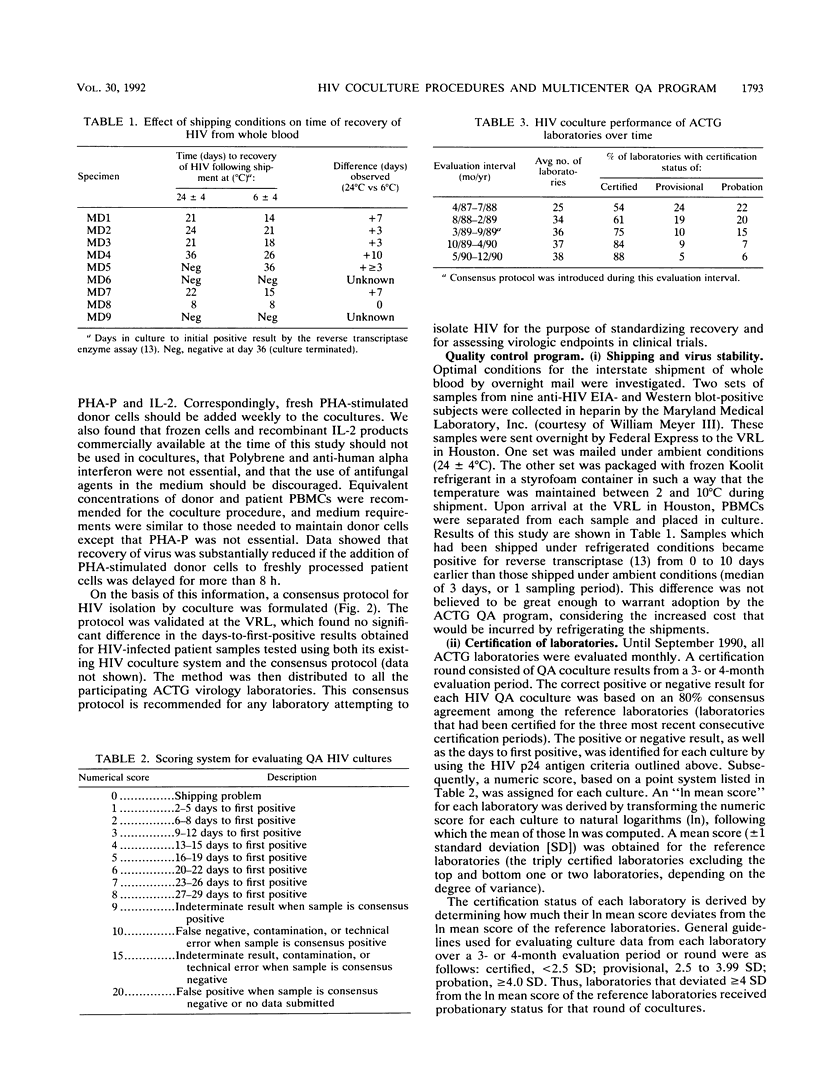
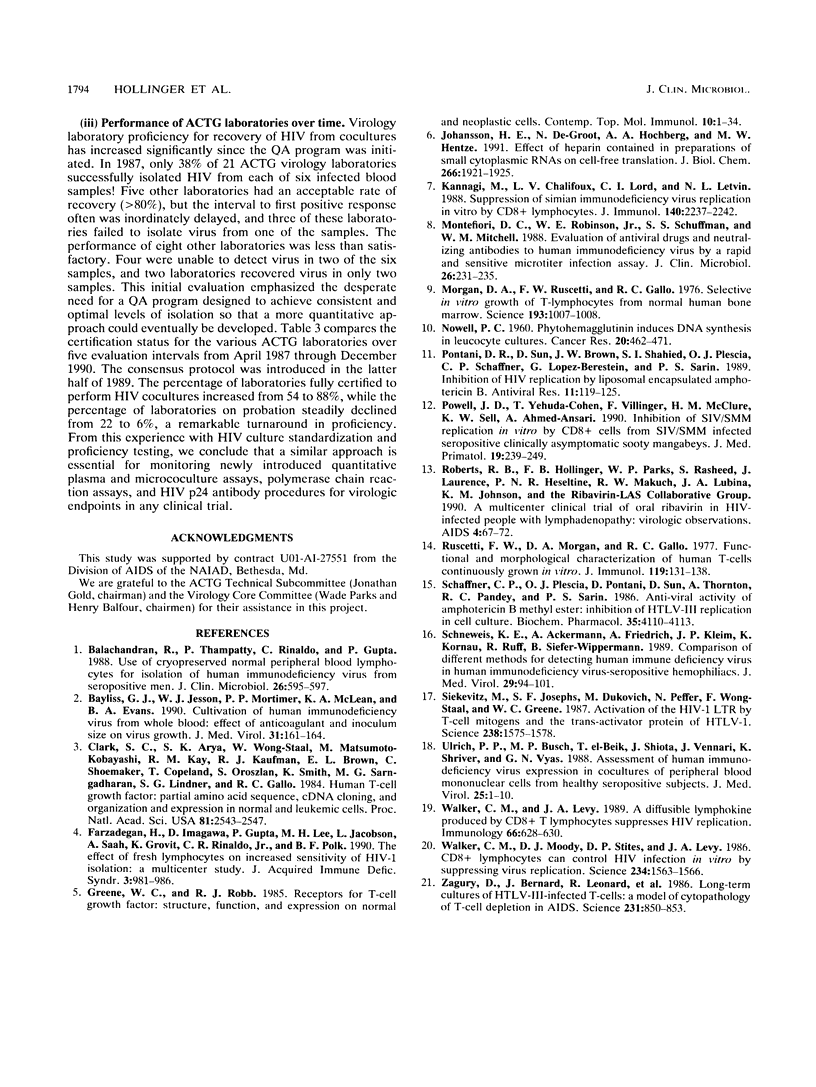
Selected References
These references are in PubMed. This may not be the complete list of references from this article.
- Balachandran R., Thampatty P., Rinaldo C., Gupta P. Use of cryopreserved normal peripheral blood lymphocytes for isolation of human immunodeficiency virus from seropositive men. J Clin Microbiol. 1988 Mar;26(3):595–597. doi: 10.1128/jcm.26.3.595-597.1988. [DOI] [PMC free article] [PubMed] [Google Scholar]
- Bayliss G. J., Jesson W. J., Mortimer P. P., McLean K. A., Evans B. A. Cultivation of human immunodeficiency virus from whole blood: effect of anticoagulant and inoculum size on virus growth. J Med Virol. 1990 Jun;31(2):161–164. doi: 10.1002/jmv.1890310215. [DOI] [PubMed] [Google Scholar]
- Clark S. C., Arya S. K., Wong-Staal F., Matsumoto-Kobayashi M., Kay R. M., Kaufman R. J., Brown E. L., Shoemaker C., Copeland T., Oroszlan S. Human T-cell growth factor: partial amino acid sequence, cDNA cloning, and organization and expression in normal and leukemic cells. Proc Natl Acad Sci U S A. 1984 Apr;81(8):2543–2547. doi: 10.1073/pnas.81.8.2543. [DOI] [PMC free article] [PubMed] [Google Scholar]
- Farzadegan H., Imagawa D., Gupta P., Lee M. H., Jacobson L., Saah A., Grovit K., Rinaldo C. R., Jr, Polk B. F. The effect of fresh lymphocytes on increased sensitivity of HIV-1 isolation: a multicenter study. J Acquir Immune Defic Syndr. 1990;3(10):981–986. [PubMed] [Google Scholar]
- Greene W. C., Robb R. J. Receptors for T-cell growth factor: structure, function and expression on normal and neoplastic cells. Contemp Top Mol Immunol. 1985;10:1–34. doi: 10.1007/978-1-4684-4838-2_1. [DOI] [PubMed] [Google Scholar]
- Johansson H. E., De Groot N., Hochberg A. A., Hentze M. W. Effect of heparin contained in preparations of small cytoplasmic RNAs on cell-free translation. J Biol Chem. 1991 Jan 25;266(3):1921–1925. [PubMed] [Google Scholar]
- Kannagi M., Chalifoux L. V., Lord C. I., Letvin N. L. Suppression of simian immunodeficiency virus replication in vitro by CD8+ lymphocytes. J Immunol. 1988 Apr 1;140(7):2237–2242. [PubMed] [Google Scholar]
- Montefiori D. C., Robinson W. E., Jr, Schuffman S. S., Mitchell W. M. Evaluation of antiviral drugs and neutralizing antibodies to human immunodeficiency virus by a rapid and sensitive microtiter infection assay. J Clin Microbiol. 1988 Feb;26(2):231–235. doi: 10.1128/jcm.26.2.231-235.1988. [DOI] [PMC free article] [PubMed] [Google Scholar]
- NOWELL P. C. Phytohemagglutinin: an initiator of mitosis in cultures of normal human leukocytes. Cancer Res. 1960 May;20:462–466. [PubMed] [Google Scholar]
- Pontani D. R., Sun D., Brown J. W., Shahied S. I., Plescia O. J., Schaffner C. P., Lopez-Berestein G., Sarin P. S. Inhibition of HIV replication by liposomal encapsulated amphotericin B. Antiviral Res. 1989 Apr;11(3):119–125. doi: 10.1016/0166-3542(89)90023-5. [DOI] [PubMed] [Google Scholar]
- Powell J. D., Yehuda-Cohen T., Villinger F., McClure H. M., Sell K. W., Ahmed-Ansari A. Inhibition of SIV/SMM replication in vitro by CD8+ cells from SIV/SMM infected seropositive clinically asymptomatic sooty mangabeys. J Med Primatol. 1990;19(3-4):239–249. [PubMed] [Google Scholar]
- Roberts R. B., Hollinger F. B., Parks W. P., Rasheed S., Laurence J., Heseltine P. N., Makuch R. W., Lubina J. A., Johnson K. M. A multicenter clinical trial of oral ribavirin in HIV-infected people with lymphadenopathy: virologic observations. Ribavirin-LAS Collaborative Group. AIDS. 1990 Jan;4(1):67–72. doi: 10.1097/00002030-199001000-00009. [DOI] [PubMed] [Google Scholar]
- Ruscetti F. W., Morgan D. A., Gallo R. C. Functional and morphologic characterization of human T cells continuously grown in vitro. J Immunol. 1977 Jul;119(1):131–138. [PubMed] [Google Scholar]
- Schaffner C. P., Plescia O. J., Pontani D., Sun D., Thornton A., Pandey R. C., Sarin P. S. Anti-viral activity of amphotericin B methyl ester: inhibition of HTLV-III replication in cell culture. Biochem Pharmacol. 1986 Nov 15;35(22):4110–4113. doi: 10.1016/0006-2952(86)90037-7. [DOI] [PubMed] [Google Scholar]
- Siekevitz M., Josephs S. F., Dukovich M., Peffer N., Wong-Staal F., Greene W. C. Activation of the HIV-1 LTR by T cell mitogens and the trans-activator protein of HTLV-I. Science. 1987 Dec 11;238(4833):1575–1578. doi: 10.1126/science.2825351. [DOI] [PubMed] [Google Scholar]
- Ulrich P. P., Busch M. P., el-Beik T., Shiota J., Vennari J., Shriver K., Vyas G. N. Assessment of human immunodeficiency virus expression in cocultures of peripheral blood mononuclear cells from healthy seropositive subjects. J Med Virol. 1988 May;25(1):1–10. doi: 10.1002/jmv.1890250102. [DOI] [PubMed] [Google Scholar]
- Walker C. M., Levy J. A. A diffusible lymphokine produced by CD8+ T lymphocytes suppresses HIV replication. Immunology. 1989 Apr;66(4):628–630. [PMC free article] [PubMed] [Google Scholar]
- Walker C. M., Moody D. J., Stites D. P., Levy J. A. CD8+ lymphocytes can control HIV infection in vitro by suppressing virus replication. Science. 1986 Dec 19;234(4783):1563–1566. doi: 10.1126/science.2431484. [DOI] [PubMed] [Google Scholar]
- Zagury D., Bernard J., Leonard R., Cheynier R., Feldman M., Sarin P. S., Gallo R. C. Long-term cultures of HTLV-III--infected T cells: a model of cytopathology of T-cell depletion in AIDS. Science. 1986 Feb 21;231(4740):850–853. doi: 10.1126/science.2418502. [DOI] [PubMed] [Google Scholar]


